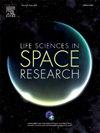Space radiation and risk for ocular surface malignancies: Exposure risk, current mitigation strategies, and management considerations for a mission to Mars
IF 2.8
3区 生物学
Q2 ASTRONOMY & ASTROPHYSICS
引用次数: 0
Abstract
Ocular surface tumors, originating from either the conjunctiva or the cornea, primarily fall into three categories of malignant or premalignant neoplasms: ocular surface squamous neoplasia (OSSN), ocular surface melanocytic tumors, and conjunctival lymphoid tumors. These neoplasms can originate from either the conjunctiva or the cornea. Exposure to space radiation, particularly galactic cosmic rays, and solar particle events, poses a significant threat to astronaut health, including the development of ocular malignancies. As such, the objective of this study was to describe the exposure risk for ocular surface malignancies, current mitigation strategies, and management considerations for a mission to Mars. The current mitigation strategies for space radiation include physical and structural shielding along with dietary interventions. Additionally, management of ocular health during a Mars mission can include holoportation, AI-powered diagnostics, newest in-space surgical technology, optical coherence tomography (OCT), and more. Conclusively, further research and collaboration amongst space and healthcare professionals is necessary to ensure the safety and well-being of astronauts during future space exploration endeavors.
空间辐射和眼表恶性肿瘤的风险:暴露风险、当前缓解战略和火星任务的管理考虑
眼表肿瘤起源于结膜或角膜,主要分为三类恶性或癌前肿瘤:眼表鳞状瘤变(OSSN)、眼表黑色素细胞瘤和结膜淋巴样瘤。这些肿瘤可起源于结膜或角膜。暴露于空间辐射,特别是银河宇宙射线和太阳粒子事件,对宇航员的健康构成重大威胁,包括形成眼部恶性肿瘤。因此,本研究的目的是描述眼表恶性肿瘤的暴露风险、目前的缓解战略以及火星任务的管理考虑。目前的空间辐射减缓战略包括物理和结构屏蔽以及饮食干预。此外,火星任务期间的眼部健康管理可以包括全息传送、人工智能诊断、最新的太空手术技术、光学相干断层扫描(OCT)等。最后,有必要在空间和保健专业人员之间进行进一步的研究和合作,以确保宇航员在未来的空间探索努力期间的安全和福祉。
本文章由计算机程序翻译,如有差异,请以英文原文为准。
求助全文
约1分钟内获得全文
求助全文
来源期刊

Life Sciences in Space Research
Agricultural and Biological Sciences-Agricultural and Biological Sciences (miscellaneous)
CiteScore
5.30
自引率
8.00%
发文量
69
期刊介绍:
Life Sciences in Space Research publishes high quality original research and review articles in areas previously covered by the Life Sciences section of COSPAR''s other society journal Advances in Space Research.
Life Sciences in Space Research features an editorial team of top scientists in the space radiation field and guarantees a fast turnaround time from submission to editorial decision.
 求助内容:
求助内容: 应助结果提醒方式:
应助结果提醒方式:


